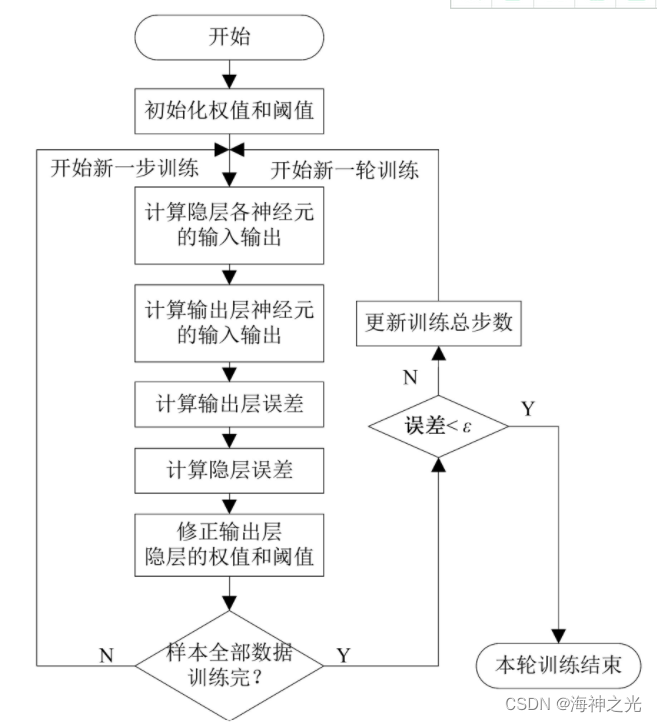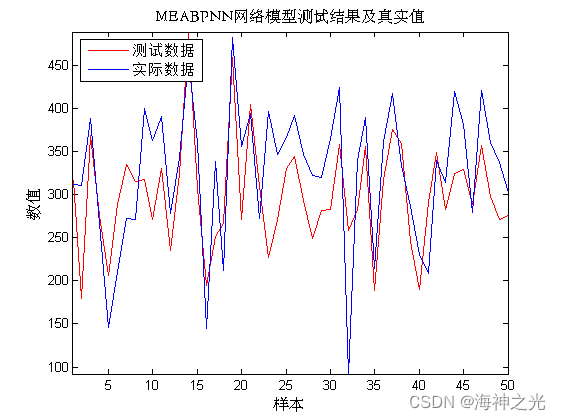【BP回归预测】基于matlab思维进化算法优化BP神经网络回归预测【含Matlab源码 2031期】
一、思维进化算法及BP神经网络简介
1 思维进化算法的选择与改进
1.1 算法选择
深度学习与人工智能发展迅速,在疾病预测方面也起到至关重要的作用。通过对比Logistic回归模型和BP神经网络两种模型,并将模型预测结果与传统的Logistic回归模型预测结果进行分析发现,基于BP神经网络建立2型糖尿病预测模型较好,最终选择BP神经网络作为糖尿病并发症的预测模型[14]。
1.2 算法基本思路
在思维进化算法的解空间内,由于思维进化算法(mind evolutionary algorithm,MEA)可以记忆不止一代的进化信息,因此会随机产生不同规模大小的个体,根据这一特点可以在解空间中搜索出得分最高的、性能最好的临时个体和优胜个体。将得分最高的临时个体与优胜个体作为整个解空间的中心点,并在其周围产生和包裹一层层的新的个体。可以在整个解空间内进行子群体内部执行趋同操作,直至解空间的所有个体基本成熟后,并以该子群体中最优个体(即中心)的得分作为该子群体的得分。将整个解空间分为临时个体和优胜个体两个部分,因此其趋同与异化操作可以同时进行,互不影响和干扰,并可分别提高准确率,从而为改进BP神经网络的权值和阈值起到至关重要的作用。
2 思维进化算法优化BP神经网络
BP神经网络具有多层前馈神经网络,信号向前传播,误差反向传递,根据预测的误差实时调整网络的权值和阈值,进而使得预测值不断接近期望值。其训练过程如图1所示,主要包括以下步骤,首先对网格初始化,确定计算的初始权值和阈值,将样本数据输入至模型后,会计算出隐层各神经元的输入以及输出,接着计算输出层神经元的输入与输出,获取计算输出层和隐层的误差,根据误差值,对输出层进行修正,并且修改隐层的权值和阈值,判断迭代步数以及误差值是否满足设定值,进而决定是否终止训练。

图1 BP神经网络训练流程图
由以上步骤的分析,在算法中有两个关键的参数是神经网络初始的权值和阈值,这两个值可以决定算法的效率和预测精度,为了更好地确定BP神经网络中的权值和阈值,故引入思维进化算法对其展开研究。
思维进化算法的核心类似于人类思维的进化过程,是在遗传算法基础上衍生出来的新型进化算法,在保留遗传算法的基础啊上,提出新的“趋同”和“异化”两种新的操作算子,通过趋同、异化等操作,不断迭代使得预测值与期望值逐渐逼近。其基本流程如图2所示,在获取样本数据之后,算法会产生初始种群、优胜子种群以及临时子种群,之后子种群执行趋同操作,获取成熟的子群体,之后进行异化操作进而获取全局最优的个体,将此个体作为训练BP神经网络的初始权值和阈值,使得BP神经网络以更快的速率和精度获取预测值。
二、部分源代码
%% 清空环境变量
clear
clc
close all
warning off
%% 导入数据
load data
data=[attributes’ strength’];
% 输入数据
input =data(:,1:4)‘;
output=data(:,5)’;
% 随机生成训练集、测试集
k = randperm(size(input,2));
N = 24;
% 训练集
P_train=input(:,k(1:N));
T_train=output(k(1:N));
% 测试集
P_test=input(:,k(N+1:end));
T_test=output(k(N+1:end));
%% 归一化
% 训练集
[Pn_train,inputps] = mapminmax(P_train);
Pn_test = mapminmax(‘apply’,P_test,inputps);
% 测试集
[Tn_train,outputps] = mapminmax(T_train);
Tn_test = mapminmax(‘apply’,T_test,outputps);
%% 参数设置
popsize = 200; % 种群大小
bestsize = 5; % 优胜子种群个数
tempsize = 5; % 临时子种群个数
SG = popsize / (bestsize+tempsize); % 子群体大小
S1 = size(Pn_train,1); % 输入层神经元个数
S2 = 5; % 隐含层神经元个数
S3 = size(Tn_train,1); % 输出层神经元个数
iter = 10; % 迭代次数
%% 随机产生初始种群
initpop = initpop_generate(popsize,S1,S2,S3,Pn_train,Tn_train);
%% 产生优胜子群体和临时子群体
% 得分排序
[sort_val,index_val] = sort(initpop(:,end),‘descend’);
% 产生优胜子种群和临时子种群的中心
bestcenter = initpop(index_val(1:bestsize)😅;
tempcenter = initpop(index_val(bestsize+1:bestsize+tempsize)😅;
% 产生优胜子种群
bestpop = cell(bestsize,1);
for i = 1:bestsize
center = bestcenter(i,:);
bestpop{i} = subpop_generate(center,SG,S1,S2,S3,Pn_train,Tn_train);
end
% 产生临时子种群
temppop = cell(tempsize,1);
for i = 1:tempsize
center = tempcenter(i,:);
temppop{i} = subpop_generate(center,SG,S1,S2,S3,Pn_train,Tn_train);
end
while iter > 0
%% 优胜子群体趋同操作并计算各子群体得分
best_score = zeros(1,bestsize);
best_mature = cell(bestsize,1);
for i = 1:bestsize
best_mature{i} = bestpop{i}(1,:);
best_flag = 0; % 优胜子群体成熟标志(1表示成熟,0表示未成熟)
while best_flag == 0
% 判断优胜子群体是否成熟
[best_flag,best_index] = ismature(bestpop{i});
% 若优胜子群体尚未成熟,则以新的中心产生子种群
if best_flag == 0
best_newcenter = bestpop{i}(best_index,:);
best_mature{i} = [best_mature{i};best_newcenter];
bestpop{i} = subpop_generate(best_newcenter,SG,S1,S2,S3,Pn_train,Tn_train);
end
end
% 计算成熟优胜子群体的得分
best_score(i) = max(bestpop{i}(:,end));
end
% 绘图(优胜子群体趋同过程)
figure(1)
temp_x = 1:length(best_mature{1}(:,end))+5;
temp_y = [best_mature{1}(:,end);repmat(best_mature{1}(end),5,1)];
plot(temp_x,temp_y,‘b-o’)
hold on
temp_x = 1:length(best_mature{2}(:,end))+5;
temp_y = [best_mature{2}(:,end);repmat(best_mature{2}(end),5,1)];
plot(temp_x,temp_y,‘r-^’)
hold on
temp_x = 1:length(best_mature{3}(:,end))+5;
temp_y = [best_mature{3}(:,end);repmat(best_mature{3}(end),5,1)];
plot(temp_x,temp_y,‘k-s’)
hold on
temp_x = 1:length(best_mature{4}(:,end))+5;
temp_y = [best_mature{4}(:,end);repmat(best_mature{4}(end),5,1)];
plot(temp_x,temp_y,‘g-d’)
hold on
temp_x = 1:length(best_mature{5}(:,end))+5;
temp_y = [best_mature{5}(:,end);repmat(best_mature{5}(end),5,1)];
plot(temp_x,temp_y,‘m-*’)
legend(‘子种群1’,‘子种群2’,‘子种群3’,‘子种群4’,‘子种群5’)
xlim([1 10])
xlabel(‘趋同次数’)
ylabel(‘得分’)
title(‘优胜子种群趋同过程’)
%% 临时子群体趋同操作并计算各子群体得分
temp_score = zeros(1,tempsize);
temp_mature = cell(tempsize,1);
for i = 1:tempsize
temp_mature{i} = temppop{i}(1,:);
temp_flag = 0; % 临时子群体成熟标志(1表示成熟,0表示未成熟)
while temp_flag == 0
% 判断临时子群体是否成熟
[temp_flag,temp_index] = ismature(temppop{i});
% 若临时子群体尚未成熟,则以新的中心产生子种群
if temp_flag == 0
temp_newcenter = temppop{i}(temp_index,:);
temp_mature{i} = [temp_mature{i};temp_newcenter];
temppop{i} = subpop_generate(temp_newcenter,SG,S1,S2,S3,Pn_train,Tn_train);
end
end
% 计算成熟临时子群体的得分
temp_score(i) = max(temppop{i}(:,end));
end
% 绘图(临时子群体趋同过程)
figure(2)
temp_x = 1:length(temp_mature{1}(:,end))+5;
temp_y = [temp_mature{1}(:,end);repmat(temp_mature{1}(end),5,1)];
plot(temp_x,temp_y,'b-o')
hold on
temp_x = 1:length(temp_mature{2}(:,end))+5;
temp_y = [temp_mature{2}(:,end);repmat(temp_mature{2}(end),5,1)];
plot(temp_x,temp_y,'r-^')
hold on
temp_x = 1:length(temp_mature{3}(:,end))+5;
temp_y = [temp_mature{3}(:,end);repmat(temp_mature{3}(end),5,1)];
plot(temp_x,temp_y,'k-s')
hold on
temp_x = 1:length(temp_mature{4}(:,end))+5;
temp_y = [temp_mature{4}(:,end);repmat(temp_mature{4}(end),5,1)];
plot(temp_x,temp_y,'g-d')
hold on
temp_x = 1:length(temp_mature{5}(:,end))+5;
temp_y = [temp_mature{5}(:,end);repmat(temp_mature{5}(end),5,1)];
plot(temp_x,temp_y,'m-*')
legend('子种群1','子种群2','子种群3','子种群4','子种群5')
xlim([1 10])
xlabel('趋同次数')
ylabel('得分')
title('临时子种群趋同过程')
%% 异化操作
[score_all,index] = sort([best_score temp_score],'descend');
% 寻找临时子群体得分高于优胜子群体的编号
rep_temp = index(find(index(1:bestsize) > bestsize)) - bestsize;
% 寻找优胜子群体得分低于临时子群体的编号
rep_best = index(find(index(bestsize+1:end) < bestsize+1) + bestsize);
% 若满足替换条件
if ~isempty(rep_temp)
% 得分高的临时子群体替换优胜子群体
for i = 1:length(rep_best)
bestpop{rep_best(i)} = temppop{rep_temp(i)};
end
% 补充临时子群体,以保证临时子群体的个数不变
for i = 1:length(rep_temp)
temppop{rep_temp(i)} = initpop_generate(SG,S1,S2,S3,Pn_train,Tn_train);
end
else
break;
end
%% 输出当前迭代获得的最佳个体及其得分
if index(1) < 6
best_individual = bestpop{index(1)}(1,:);
else
best_individual = temppop{index(1) - 5}(1,:);
end
iter = iter - 1;
- 1
- 2
- 3
- 4
- 5
- 6
- 7
- 8
- 9
- 10
- 11
- 12
- 13
- 14
- 15
- 16
- 17
- 18
- 19
- 20
- 21
- 22
- 23
- 24
- 25
- 26
- 27
- 28
- 29
- 30
- 31
- 32
- 33
- 34
- 35
- 36
- 37
- 38
- 39
- 40
- 41
- 42
- 43
- 44
- 45
- 46
- 47
- 48
- 49
- 50
- 51
- 52
- 53
- 54
- 55
- 56
- 57
- 58
- 59
- 60
- 61
- 62
- 63
- 64
- 65
- 66
- 67
- 68
- 69
- 70
- 71
- 72
- 73
- 74
- 75
end
三、运行结果

四、matlab版本及参考文献
1 matlab版本
2014a
2 参考文献
[1]韦哲,石栋栋,王能才,赵刚,王玉珍,石恒兵.基于思维进化算法优化的BP神经网络对糖尿病并发症的预测研究[J].中国医学装备. 2020,17(10)
[2]冯培存,魏正英,张育斌,张千,张磊,贾维兵.基于思维进化算法优化BP神经网络的温室甜瓜ET0预测研究[J].节水灌溉. 2019,(09)
3 备注
简介此部分摘自互联网,仅供参考,若侵权,联系删除
文章来源: qq912100926.blog.csdn.net,作者:海神之光,版权归原作者所有,如需转载,请联系作者。
原文链接:qq912100926.blog.csdn.net/article/details/126292078
- 点赞
- 收藏
- 关注作者



评论(0)